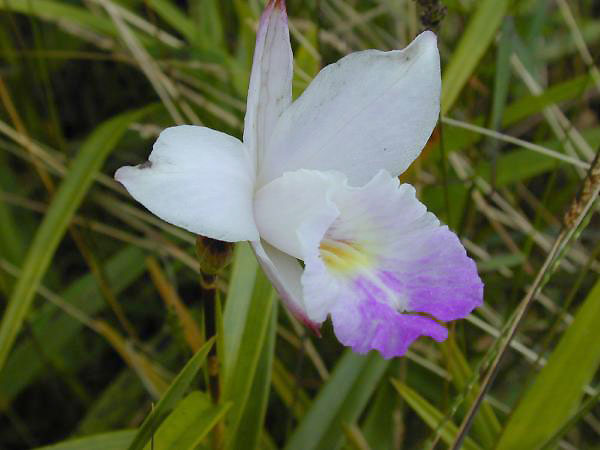- Arundina graminifolia
Taxobox
name = Arundina graminifolia

image_width = 250px
regnum =Plant ae
divisio = Magnoliophyta
classis = Liliopsida
ordo =Asparagales
familia =Orchidaceae
subfamilia =Epidendroideae
tribus =Arethuseae
subtribus =Bletiinae
alliance = Arundina
genus = "Arundina"
genus_authority = Rich.
species = "A. graminifolia"
binomial = "Arundina graminifolia"
binomial_authority = (D.Don )Hochr. The bamboo orchid ("Arundina graminifolia";
syn. "Arundina bambusifolia" Lindl., "Arundina speciosa" Blume, "Bletia graminifolia" D.Don) is aspecies oforchid and the sole member of the genus "Arundina". This tropicalAsia tic genus extends fromIndia ,Nepal ,Thailand ,Malaysia ,Singapore ,South China toIndonesia and across thePacific Islands . It was introduced toPuerto Rico ,Costa Rica , Guatemala andPanama .The bamboo orchid is a terrestrial multiperennial orchid with reedy stems, forming large clumps growing to a height of 70 cm to 2 m.
The plaited linear leaves are oblong lanceolate, with a length of 9 to 19 cm and a width of 0.8 to 1.5 cm. The
apex is acuminate. There are amplexicaul (clasping the stem) sheaths.
This orchid blooms in summer and autumn, showing rather open clusters of showy terminalflowers , ten at the most. They bloom in succession on the terminalraceme s, which are 7 to 16 cm long. These flowers, 5 – 8 cm in diameter, are a rosy lilac and white disk with a purple lip. The bracts are wide triangular and surround the main stalk of the flower cluster. The occasional fertilized seed pods contain minute powdery seeds, and small plants often develop near the cane ends after flowering, and likely aid in propagation if allowed to reach the soil.With only 200 of the plant to be recorded growing naturally in
Singapore , the species is close to extinction there, largely because of destruction of its natural habitat, namely therainforest s andmangrove forests. The remaining plants, commonly called Tapah weeds, can be found in the secondary forests or at the forest fringes. It is however very common in road cuts and other disturbed areas in full sun in Sarawak, East Malaysia, where it often is the most common flowering plant to be seen along the roadsides.
Wikimedia Foundation. 2010.
